Home » Rocks » Igneous Rocks » Pegmatite
Pegmatite
An extreme igneous rock with large crystals and rare minerals
Article by: Hobart M. King, PhD
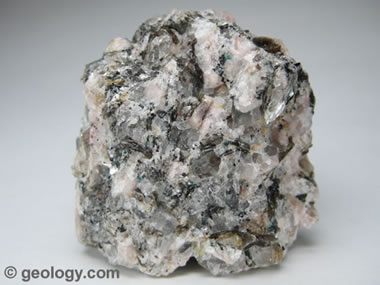
Pegmatite: Pegmatite is an igneous rock composed almost entirely of crystals that are over one centimeter in diameter. The specimen shown here is about two inches (five centimeters) across.
What is Pegmatite?
Pegmatites are extreme igneous rocks that form during the final stage of a magma’s crystallization. They are extreme because they contain exceptionally large crystals and they sometimes contain minerals that are rarely found in other types of rocks.
To be called a "pegmatite," a rock should be composed almost entirely of crystals that are at least one centimeter in diameter. The name "pegmatite" has nothing to do with the mineral composition of the rock.
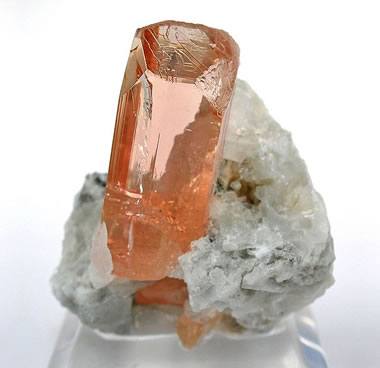
Topaz on albite: A crystal of imperial topaz on an albite matrix from a pocket in the Katlang Pegmatite of Pakistan. Specimen is about 4.5 x 3.5 x 3.5 centimeters. Specimen and photo by Arkenstone / www.iRocks.com.
Most pegmatites have a composition that is similar to granite with abundant quartz, feldspar, and mica. These are sometimes called "granite pegmatites" to indicate their mineralogical composition. However, compositions such as "gabbro pegmatite," "syenite pegmatite," and any other plutonic rock name combined with "pegmatite" are possible.
Pegmatites are sometimes sources of valuable minerals such as spodumene (an ore of lithium) and beryl (an ore of beryllium) that are rarely found in economic amounts in other types of rocks. They also can be a source of gemstones. Some of the world’s best tourmaline, aquamarine, and topaz deposits have been found in pegmatites.

Giant spodumene crystals: Molds of giant spodumene crystals at the Etta Mines, Black Hills, Pennington County, South Dakota. Note miner at right center for scale. USGS photo.
The Rock with Large Crystals
Large crystals in igneous rocks are usually attributed to a slow rate of crystallization. However, with pegmatites, large crystals are attributed to low-viscosity fluids that allow ions to be very mobile.
During the early states of a magma’s crystallization, the melt usually contains a significant amount of dissolved water and other volatiles such as chlorine, fluorine, and carbon dioxide. Water is not removed from the melt during the early crystallization process, so its concentration in the melt grows as crystallization progresses. Eventually there is an overabundance of water, and pockets of water separate from the melt.
These pockets of superheated water are extremely rich in dissolved ions. The ions in the water are much more mobile than ions in the melt. This allows them to move about freely and form crystals rapidly. This is why crystals of a pegmatite grow so large.
The extreme conditions of crystallization sometimes produce crystals that are several meters in length and weigh over one ton. For example: a large crystal of spodumene at the Etta Mine in South Dakota was 42 feet long, 5 feet in diameter and yielded 90 tons of spodumene!
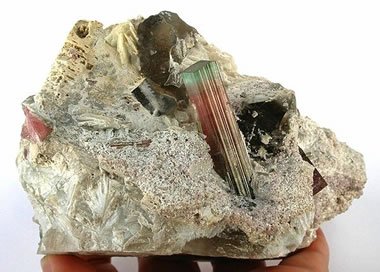
Himalaya pegmatite: A specimen of the Himalaya Pegmatite of San Diego County, California, that is famous for yielding gem- and mineral-specimen-quality tourmaline and other fine crystals. This is a pocket piece with feldspar, smoky quartz, cleavelandite, and a fantastic multicolor tourmaline crystal. Specimen is about 12.7 x 7.7 x 7.5 centimeters. Specimen and photo by Arkenstone / www.iRocks.com.
Activity at the Margins of a Batholith
Pegmatites form from waters that separate from a magma in the late stages of crystallization; this activity often occurs in small pockets along the margins of a batholith. Pegmatite can also form in fractures that develop on the margins of the batholith. This is how "pegmatite dikes" are formed.
Because these dikes and pockets are small in size, the mining operations that exploit them are also small. The mining of pegmatites might be done in an underground operation that follows a dike or exploits a small pocket. It can also be done at an outcrop where the pegmatite is easily discovered by people. Pegmatites usually do not support large mining operations that employ dozens of workers and have continuous activity of many years.
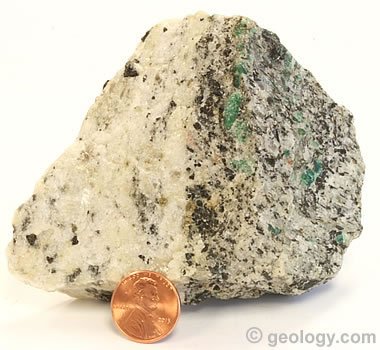
Crabtree pegmatite: One of the most interesting pegmatites is the Crabtree Pegmatite of western North Carolina. It is a granitic pegmatite that intrudes the boundary between two rock units in a dike that is up to two meters wide. It was mined for emeralds by a series of owners, which included Tiffany and Company, between 1894 and the 1990s. Many fine clear emeralds were produced, and much of the rock was sold as "emerald matrix" for slabbing and cabochon cutting. This specimen is about 7 x 7 x 7 centimeters in size and contains numerous small emerald crystals that are several millimeters in length.
Rare Minerals in Large Crystals
In the early stages of crystallization, the ions that form high-temperature minerals are depleted from the melt. Rare ions that do not participate in the crystallization of common rock-forming minerals become concentrated in the melt and in the excluded water. These ions can form the rare minerals that are often found in pegmatites. Examples are small ions such as lithium and beryllium that form spodumene and beryl; or large ions such as tantalum and niobium that form minerals such as tantalite and niobite. Rare elements concentrated in large crystals make pegmatite a potential source of valuable ore.
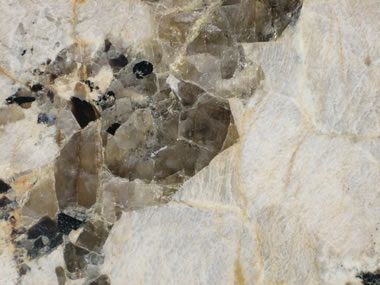
Polished pegmatite countertop: A portion of a countertop made from polished pegmatite. Large crystals of feldspar, smoky quartz, and hornblende are visible. The view seen here is about 12 inches across.
Uses of Pegmatite
Pegmatite rock has very few uses. However, pegmatite deposits often contain gemstones, industrial minerals, and rare minerals.
ARCHITECTURAL STONE
Pegmatite rock has limited use as an architectural stone. Occasionally it is encountered in a dimension stone quarry that produces granite for architectural use. If the pegmatite is sound and attractive, it might be cut into slabs and polished for building facing, countertops, tile or other decorative stone products and sold commercially as a "granite."

Polished pegmatite countertop: A portion of a countertop made from polished pegmatite. Large crystals of feldspar, quartz, and hornblende are visible. The view seen here is about six inches across.
GEMSTONE MINING
Some of the world’s best gemstone mines are in pegmatites. Gemstones found in pegmatite include: amazonite, apatite, aquamarine, beryl, chrysoberyl, emerald, garnet, goshenite, heliodor, kunzite, lepidolite, morganite, spodumene, topaz, tourmaline, zircon, and many others. Large crystals of excellent-quality material are often found in pegmatite.
RARE MINERALS
Pegmatite is the host rock for many rare mineral deposits. These minerals can be commercial sources of: beryllium, bismuth, boron, cesium, lithium, molybdenum, niobium, tantalum, tin, titanium, tungsten, and many other elements. In most cases the mining operations are very small, employing less than a dozen people. If the mine contains nice crystals, the minerals are often more valuable as mineral specimens and faceting rough than being sold as an ore.
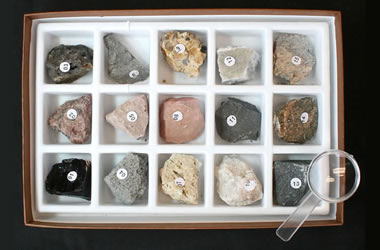
Rock & Mineral Kits: Get a rock, mineral, or fossil kit to learn more about Earth materials. The best way to learn about rocks is to have specimens available for testing and examination.
INDUSTRIAL MINERALS
Pegmatite is often mined for industrial minerals. Large sheets of mica are mined from pegmatite. These are used to make components for electronic devices, retardation plates, circuit boards, optical filters, detector windows, and many other products. Feldspar is another mineral frequently mined from pegmatite. It is used as a primary ingredient for making glass and ceramics. It is also used as a filler in many products.
| More Rocks |
 |
Tumbled Stones |
 |
Fossils |
 |
Geodes |
 |
The Rock Used to Make Beer |
 |
Topo Maps |
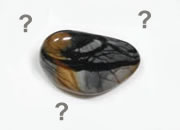 |
Difficult Rocks |
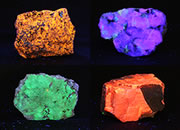 |
Fluorescent Minerals |
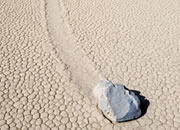 |
Sliding Rocks on Racetrack Playa |

Find Other Topics on Geology.com:

|

| ||

|

| ||

|

| ||

|

|
